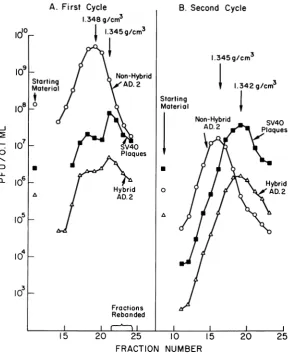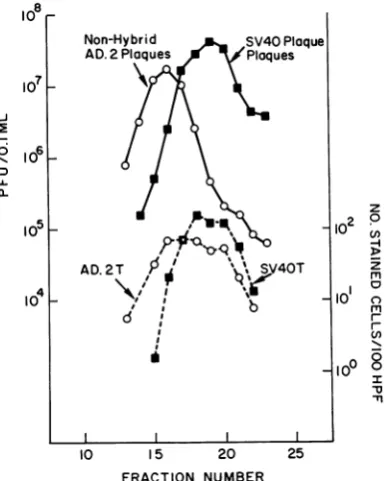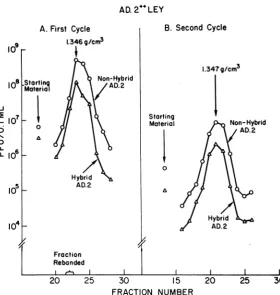Copyright © 1970 American Society for Microbiology Printed in U.S.A.
Equilibrium
Density Gradient
Studies
onSimian
Virus
40-Yielding
Variants of
the Adenovirus
Type 2-Simian
Virus
40
Hybrid
Population
WILLIAM H. WIESE, ANDREW M. LEWIS, JR., AND WALLACE P. ROWE
Laboratory of Viral Diseases, NationalInstituteofAllergyandInfectiousDiseases,Bethesda,Maryland 20014
Received for publication3 December 1969
The simian virus 40 (SV40)-yielding variants of the adenovirus type 2
(Ad.2)-SV40 hybrid (Ad.2++) populationwerestudied bymeansoffixed-angle equilibrium density gradient centrifugation in cesium chloride. The hybridvirions of theAd.2++ high-efficiency yielder population banded at densities of 0.004 g/cm3 lighter than
the nonhybrid Ad.2 virions. The degree of separation of the hybrid particles was
sufficienttopermitgreaterthan 100-fold relative purificationbytwo cycles of
cen-trifugation. Hybrid particles that produce adenovirus plaques in African green monkey kidney cells by two-hit kinetics (one-hit kinetics when assayed on lawns
ofnonhybrid adenovirus)werenotseparable from the particlesthat yieldSV40virus. Thehybrid particle in theAd.2++low-efficiency yielderpopulationwas not separa-ble from thenonhybrid Ad.2 virions.
Two genetically stable variants have been isolated from the adenovirus type 2
(Ad.2)-simian virus 40
(SV40)
hybrid (Ad.2<)
popula-tion (6).
Designated
Ad.2++high-efficiency
yielders(HEY) and Ad.2++
low-efficiency yielders
(LEY), these
populations
aredistinguished
by the relativeefficiency
with which adenovirus-encapsidatedparticles
containing
the SV40 genomesynthesize
SV40 virus. Bothpopulations
consist of
nonhybrid
Ad.2virions,
small quan-tities ofnonhybrid
SV40virions,
and adenovirus-encapsidatedparticles
containing
infectiousSV40 genome. Bothpopulations
induce adenovirus plaquesby
two-hit kinetics in African green monkey kidney(AGMK)
cells. Adenovirus plaque formation inmonkey
cells can becon-verted to one-hit
by co-infecting
with lawns of nonhybrid adenovirus virions.Progeny
from either one-hit or two-hit adenovirusplaques
reproducethe parent
population.
In the
Ad.2+
HEYpopulation,
adenovirus-encapsidated
particles
containing
the infectious SV40 genome produce SV40plaques
efficiently
in AGMK cells at
high
titers and with one-hit kinetics. Plaque studies on the Ad.2+ LEY population demonstrate that it contains similar quantities ofadenovirus-encapsidated
particles
containingtheinfectious SV40genome;
however,
only1 of every 104 such
particles produces
SV40 plaques in AGMK cells. Theplaquing
charac-teristics of the Ad.2+ HEY and LEY variants aredescribed intheaccompanying paper (6).
Studies on the adenovirus 7 (Ad.7; E46+) hy-brid have demonstrated that partial separation of the hybrid and nonhybrid components of this population can be obtained by fixed-angle equilibrium density gradient centrifugation in cesium chloride (CsCl; 2). The purpose of this study was to attempt to separate hybrid from nonhybrid virions and to characterize the sedi-mentation properties of the biologically different componentsintheAd.2++HEYand LEY popula-tions by using the centrifugation procedures described by Baum et al. (2). This was a par-ticularly relevent approach to the question of whether the
hybrid
particle which induces SV40 plaques contains markedly less deoxyribonucleic acid(DNA)
than theparticleinducing
adenovirus plaques; this would be anticipated ifthe former weresimplyadenovirus-encapsidated
SV40DNA.MATERIALS AND METHODS
Virus. The isolation and characterization of the
HEY and LEY variants of the Ad.2++ population have beendescribed (6). Pools of Ad.2+ HEY and Ad.2++ LEY representing thethird AGMK passage level afterisolation from the Ad.2 parentpoolwere
prepared in AGMK monolayers infected with an
inoculum of10plaque-forming units (PFU) or more
ofnonhybrid Ad.2 percell. Cultures wereharvested 421
on November 11, 2019 by guest
http://jvi.asm.org/
when 75% of the monolayer exhibited adenovirus cytopathic effect. The Ad.2++ HEY pool was grown in the presence of SV40 rabbit antiserum. The pools consisted of the cells from two 32-oz flask cultures scraped intoasmallvolume of culture fluid.
Virus purification. A modification of the enzyme digestiontechniqueof Burnett (3)wasused topurify the virus pools. Infected cell packs were frozen and thawed three times and suspended in tris(hydroxy-methyl)aminomethane(Tris)-bufferedsaline(pH 7.4), with calcium (0.001 M) and magnesium (0.001 M). Thecellsuspensions weredigested at37C with pan-creatic ribonuclease and deoxyribonuclease one
(Worthington Biochemical Corp., Freehold, N.J.),100
,og/ml
ofeachfor30min,followedbyasecond 30-min digestion with crude snakevenom (Crotalus adaman-teus,K & KLaboratories,Jamaica,N.Y.),100l,g/ml for 30 min. Finally, thecell packs weretreated with alpha-chymotrypsin (Worthington Biochemical) and subtilisin, (Nargase andCo., Ltd.) 100,g/mlofeach for 45 min. The digest was layeredon a cushion of 4.5-mlCsCl,densityof 1.45g/cm3andcentrifugedinaSpincoSW25.1 rotor at55,000X gfor 90 minat4 C. Thelayer of virus below the interface was collected with a finely drawn Pasteur pipette in a volume of approximately1.0ml; this cushionedvirusconstituted thestarting materialfor theseparationruns.
Electron microscopyofanAd.2 cell pack carried through this procedure and banded in CsCl showed thevirionstobemonodispersedand freeof contami-nating debris (M. D. Hoggan, persotal
communica-tion). In addition, the cushioned Ad.2++ LEY virus
wassonicallytreated for1 secbyusingaBransonsonic oscillatorat6 amp.
Centrifugation.Theapplicationoffixed-angle equi-libriumcentrifugation in CsClfor the separation of adenovirus-SV40 hybrid populations has been de-scribed (2). In the presentexperiments, aSpinco 40
rotor wasusedat60,000 X g for 60to64hrateither
4 or 19 C. For each run, the virus sample was
sus-pendedinopticalgradeCsCldissolved in 0.01 MTris buffer, pH8.1. Thedensitywasadjustedto 1.35g/cm3,
and 4.5 mlwasused in each tube. Asample wasset
asideatthesametemperatureasthecentrifugefor the duration of the run and subsequently diluted and handled inparallel with the centrifuged material. At the end of the run, 0.1-mlfractionsweredeliveredbya
constant-volume displacement device through a hole in the bottom of the tube made by needle puncture. Densities were determined by refractive index on representative fractions on either side of the virus band region; in general, each fraction corresponded to density increments of0.0015g/cm3. The fractions were diluted in Eagle's minimalessentialmedium contain-ing 10% fetal bovine serum and dialyzed against phosphate-buffered saline (pH 7.2 or 7.4), further diluted, and stored at -70 C until used.
Plaque assays. The techniques for determining adenovirus plaque titers in HEK; hybrid-induced, SV40plaquetiters inAGMK; and the defective virus hybrid plaque titers in AGMK with an adeno-virus lawn have been described (4, 6, 9). Adenoadeno-virus 1 (strain Ad.71) at 0.1 PFU/cell was used as the lawn.
This lawn was sufficient to allow a proportionate (one-hit) dose-response curve without itself inducing cytopathiceffect. Due to the differences in sensitivity ofvarious lots of primary HEK and AGMKcells,all fractions from each centrifugation run were titrated for anygiven plaquetype onthe samelot of cells.
Immunofluorescence tests. The techniques for grow-ingHEK and AGMK cells on cover slips, infecting them, and testing for viral antigens by the indirect fluorescent-antibody procedure have been described (5, 7, 8).Infecting cover slips with low dilutions of fractions taken from a centrifugation run required modification of the standard technique to conserve materials. A cover slip (11 by 22 mm), bearing a
confluent HEK monolayer, was transferred onto a
smallpieceof blottingpaperinadrypetri dish so that the edgesof the cover slipwerefree from contact with the dish or blotting paper. Four drops of infecting inoculumwereplacedontothe coverslip andallowed toincubate withoccasional manual rotation at 37 C inanatmosphere ofhumidified 5%CO2.After 1 hrof adsorption, the fluidwasshaken from the coverslip, which wasthen washed twice and fed with medium containing 2% dializedagammaglobuliniccalfserum
and 10- M 5-fluorodeoxyuridine to prevent comple-tion ofthe infectious cycle and secondary infection. After 24 hr, thecoverslipswereharvested andfixed. To test for Ad.2 T antigen, abroadly reactive anti-serum pool from hamsters bearing adenovirus
12-inducedtumorswasused(10). Antiserum used totest
forSV40 Tantigenwaspooledfrom hamstersbearing transplantedSV40-inducedtumors.
RESULTS
Apurified poolof
Ad.2+
HEYwascentrifuged in a CsCl equilibrium gradient in an attempt to separate thehybrid
andnonhybrid
components. At the end ofthe run, two bands were visible: a dense lower band in fractions 17 to 20 and afaint upper one at
approximately
fraction 24. Plaque assays were performed on the 0.1-ml fractions collected inthe area of the bands(Fig.
lA).
The highest virus titers were all in the vicinityofthe lower band, ata density of 1.345 to 1.348g/cm3.
The fractionhaving
thehighest
titer ofnonhybrid Ad.2 wasmore dense by two fractions than the fraction having the highest titers of both SV40-yielding adenovirus-encap-sidated particles and the defective hybrid. The titrationcurvesof the latter twowereremarkably similar; the titers of SV40-yielding
particles
ranged from0.8 to1.2
log1o
higherthanthetiters of hybridparticles
which form adenovirus plaqueson lawns.To reducethe titer of nonhybrid Ad.2 in the fractions rich in hybrid particles, a second cycle of centrifugation was done. Samples of 0.4ml of 10-1 dilutions offractions 22, 23, and 24 were pooled and centrifuged again under similar conditions. A single, barely visible band
on November 11, 2019 by guest
http://jvi.asm.org/
A. First Cycle
1.348g/cm3
1.345g/cm3
h1
Fractions Rebanded I Al
B. Second Cycle
1.345g/cm3
1 1.342g/cm3
Starting Materi a
U 0
A
5 20 25 10 15 20 25
FRACTION NUMBER
FIG. 1. Titrations of fractions ofconsecutive centrifugations ofAd.2++ high-efficiencyyielders. A,First
cen-trifugation ofpurifiedvirusharvestedafter infection oftwoAGMKbottles; B,0.4mlof Ito10dilutionsoffractions
22,23,and 24fromA. Bothruns wereat60,000 X ginano. 40rotorat19 Cfor 64 hr in CsCl. (A repeat of
this entire experimentat8C inthefirstrunand 4C in therecycleeffectedasimilarseparation.) Symbols: 0 0,
nonhybrid Ad.2; *,SV40yieldedfrom Ad.2-encapsidated particles; A A, Ad.2+ HEY hybrid
as-sayed onAd.]lawn.Discrepanciesnotedinacomparisonofthe titersof particles producingSV40 plaques and
nonhybridAd.2 virions in thestartingmaterial inFig. IB with the titers obtainedforthe samematerialbefore
poolinginFig. IAareprobablyduetodifferencesinthe cell lotsusedfortheassays. was apparent. Fractions were collected and
as-sayed for infectivity (Fig. 1B). It is apparent from these data that the nonhybrid Ad.2 was
again more dense than either the SV40-yielding hybrid or the defective hybrid particles. The
curves for these hybrid particles were again
parallel. After this second centrifugation, their
respectiveplaque-forming capacitiesexceeded that of nonhybrid Ad.2 in the upper fractions. In fraction20, there was purification ofthe hybrid from the nonhybrid by nearly 104-fold, relative
totheproportionsintheoriginal startingmaterial. The particles producing SV40 plaques and the
hybrid plaques were approximately 0.004 g/cm3
less dense than the nonhybrid Ad.2.
Both of thecurves inFig. IA, which represent assays ofhybrid particles which produce either SV40 or adenovirus plaques, are biphasic with
minor peaks occurring in the fraction 17 to 19 region. This minor peak was not present after rebanding (Fig. 1B). Asimilar, but lessclear-cut, biphasic patternwasseen in another banding of HEY, whose results are not shown here. This suggests thepresence ofanother class ofhybrid virion in the HEY population, which is slightly
moredense thanthe nonhybrid Ad.2 virions. In
tdor
19
le
Starting Material
0
iO7k
11
LL-a-
i6
U
15
l0
l0 VOL.
on November 11, 2019 by guest
http://jvi.asm.org/
[image:3.493.109.400.64.419.2]any case, the ratio of SV40-yielders to hybrid particles forming adenovirus plaques on lawns wasthe same in thisregionasinthepeak atthe lower-density region. Clarification of this ques-tion must wait further studies.
Having effected somepurification of the Ad.2< HEY hybrid virion and the SV40-yielding par-ticlefromnonhybrid Ad.2,it waspossibletotest thehybrid particles for their capacity to induce Ad.2 Tantigen. HEKmonolayers on cover slips were infected with 102 dilutions of fractions from the second centrifugation. The resulting cover slip antigen preparation was divided and quantitatively assayed for SV40 and adenovirus Tantigens. The results are plottedinFig. 2and compared with the plaque titration assays from thesamefractions
(from
Fig. 1B). Itis seenthat SV40Tantigeninductionparalleled plaque induc-tion by hybrid particles, whereas adenovirus T antigen induction was very broad, paralleling the combined nonhybrid and hybrid plaque-inductioncurves.Attempts to separatethehybrid virions in the
Non-Hybrid SV40Plaque
AD. 2 Plaques Ploques
l0
-Jp
La.
10 5 20 25
FRACTION NUMBER
FIG. 2. Immunofluorescent titration ofsecond ceun-trifugation ofAd.2++high-efficiency yielders for
adeno-virusT and SV40 T antigens. Lowercurves areresults
of plaque assaysfrom Fig. IB. Upper curves are T
antigen assays. Adenovirus T antigen was found in
fractions rich in SV40-yielding particlesas wellas in
those rich in nonhybrid Ad.2 particles. Symbols:
O 0, nonhybridAd.2 plaques; E *, SV40
plaques; 0---0, adenovirus T antigen; SV40Tantigen.
Ad.2+ LEY population were carried out in a similar centrifugation study (Fig. 3A). A single centrifugationfailed to separate fractions bearing maximal titers of nonhybrid Ad.2 and the hybrid particles which produced adenovirus plaques onAGMK cellsinfectedwithlawns of nonhybrid adenovirus virions. The maximal titer of each was in fraction 23. However, comparison of the ratios of the respective titers in each fraction sug-gested that the denser fractions were relatively enriched with the hybrid. Accordingly, 0.35 ml of a 10-1dilution of fraction 21 was centrifuged asecond time. Evidence for separation could not beconfirmed (Fig. 3B). It would have been very desirable to determine the distribution of SV40-yielding particles in the LEY gradients; how-ever, this is a technically difficult, semi-quantita-tive procedure, and the attempted assay was not successful.
DISCUSSION
The results reported here are relevant to two of thechief problems on the nature of the SV40-yielding hybrids, that is, whether a singlehybrid genome can alternatively give rise to free SV40 or participate in adenovirus plaque production and whether the genome of the SV40-yielding particle isa true hybrid DNA.
The results with the Ad.2- HEY population are completely in accord with the hypothesis that there is a single hybrid particle. Under conditions which sharply separated the majority of the hybrid particles from the nonhybrid adenovirus particles, there was no indication that the SV40-yielding particles were dissociated from the hybrid particles capable of comple-menting and potentiating nonhybrid adenovirus. The alternative model, having two hybrid particles, one yielding only SV40 and the other yielding both types ofhybrid particle, cannot be ruled out. It seems highly unlikely that the two particles would have identical buoyant densities, unless the SV40-yielder is derived from the parent hybrid by a smallgenetic deletion. How-ever, the data essentially rule out the possibility that the SV40-yieldingparticle is asimple
trans-capsidant, containing nonhybridSV40 DNA inan adenovirus capsid. Such a particle would have a
buoyant density significantly less than observed here; also, other studies (Crumpacker et al., unpublished data) have failed to detect any free SV40 DNA in the adenovirus
particles
of Ad.2 HEY, the SV40 DNA detected being linked to Ad.2 DNA.Theefficiency with which thehybrid-rich frac-tions of the HEYgradientinduced Ad.2T
antigen
on November 11, 2019 by guest
http://jvi.asm.org/
[image:4.493.52.245.307.548.2]425
EQUILIBRIUM DENSITY GRADIENT STUDIES
AD.2++LEY
B. Second Cycle
1.347g/cm3
Starting Material
0
A
20 25 30 15
FRACTION NUMBER
Non-Hybrid
/AD.2
IlI I I
20 25 30
FIG. 3. Titrationsof fractions ofconsecutivecentrifugations of Ad.2+ low-efficiency yielders. (A) First
cen-trifugation ofpurifiedvirusharvestedfromtwoAGMKbottles. (B) Recentrifugation of0.35mlofa1-to-10dilution
offraction22fromA. Runs AandBwereeachat60,000 X ginano.40rotorat4 CinCsClfor61hr and60
hr,respectively. Symbols: 0 0,nonhybrid Ad.2;A A,hybrid assayedonAd.]lawn.
suggests linkage of the SV40 DNA with the portion of Ad.2 DNA coding for certain T antigens, as with E46+ virus (1, 10). However,
thisfinding could also be due to defective Ad.2 particles, analagous to the finding of defective, T-antigen-producing particles in the upper
por-tion ofSV40 bands (11).
The difference in buoyant density between the LEY hybrid particles and the major
com-ponentoftheHEYhybrid particles was striking
and suggests that the LEY genome contains a
much larger piece of adenovirus DNA than the HEY genome.It ispossible that this difference is
related to the markedly less efficient production of SV40 by the LEY virus. It should be noted that the relationship of the HEY and LEY viruses isnotclear; bothareplaqueisolates from the same uncloned population, but they may
haveoriginated byseparaterecombinationevents.
The present data along with those of Baum
et al. (2) indicate that the various adenovirus-SV40 hybrid viruses have distinctive buoyant densities relative to their nonhybrid helpers.
Ad.2+
LEY bands at the same density as thenonhybrid component, Ad.7 (E46+) is one
frac-tion lighter, and Ad.2++ HEY is two to three fractions lighter. The relative buoyant density should provide a useful marker, particularly in studies ofgenetic derivatives of the hybrids.
The degree of physical separation achieved with the HEY virus should facilitate study of the biological and chemical properties of the defec-tive hybrid particles by providing preparations in which they are in excess of the nonhybrid
Ad.2 virions.
LITERATURECITED
1.Baum,S.A.,P. R.Reich,C. J.Hybner,W.P.Rowe,andS.
M. Weissman. 1966. Biophysical evidence for linkage of adenovirus andSV40DNA's in adenovirus7-SV40 hybrid particles.Proc. Nat.Acad. Sci. U.S.A. 56:1509-1515. 2. Baum,S.G., W.H.Wiese,andW. P. Rowe. 1970.Density
differences between hybrid and nonhybrid particles in
twoadenovirus-simianvirus 40hybrid populations.J. Virol. 5:353-357.
3. Burnett, J. P.,A.0.Summers,J. A.Harrington, and A. C.
Dwyer. 1968. Production ofhighly labeled adenoviruses.
Appl.Microbiol. 16:1245-1250.
VOL. 5, 1970
A. First Cycle
I09
l08
l0
L11-- 1
a.id0
15
_
14
le
I
Starting MateriaI0
a
I
Fraction Rebanded
_ _
on November 11, 2019 by guest
http://jvi.asm.org/
[image:5.493.107.388.61.357.2]4. Lewis, A. M., Jr., K.0.Prigge, and W. P. Rowe. 1966.
Stud-ie3ofadenovirus-SV40 hybrid viruses. IV. An adenovirus
type2strain carrying the infectious SV40genome. Proc. Nat. Acad. Sci. U.S.A. 55:526-531.
5.Lewis, A. M., Jr., W. H. Wiese,andW. P. Rowe. 1967. The
presenceofantibodies in humanserumtoearly (T) adeno-virus antigens. Proc. Nat. Acad. Sci. U.S.A. 57:622-629. 6. Lewis, A. M., Jr., and W. P. Rowe. 1970. Isolation oftwo
plaque variants from the adenovirustype2-simian virus 40 hybridpopulation which differ in their efficiency in yielding simian virus 40. J. Virol. 5:413-420.
7.Pope, J. H., and W. P. Rowe. 1964. Detection of specific
anti-genin SV40-transformed cells by immunofluorescence. J. Exp.Med.120:121-128.
8. Pope, J. H., and W. P. Rowe. 1964. Immunofluorescent stud-ies ofadenovirus 12tumorsand of cells transformedor in-fected byadenoviruses. J. Exp. Med. 120:577-588. 9. Rapp, F., J. S. Butel, and J. L. Melnick. 1965.SV40
adenovi-rus "hybrid" populations: transfer ofSV40determinants fromonetypeofadenovirustoanother. Proc. Nat. Acad. Sci.U.S.A.54:717-724.
10. Rowe, W. P., and W. E. Pugh. 1966. Studies of adenovirus-SV40hybrid viruses. V. Evidence for linkage between adeno-virus and SV40 genetic materials. Proc. Nat. Acad. Sci. U.S.A.55:1126-1132.
11. Uchida, S., K. Yoshiike, S. Watanabe, and A. Furuno. 1968. Antigen-forming defective viruses of simian virus 40. Vi-rology34:1-8.


